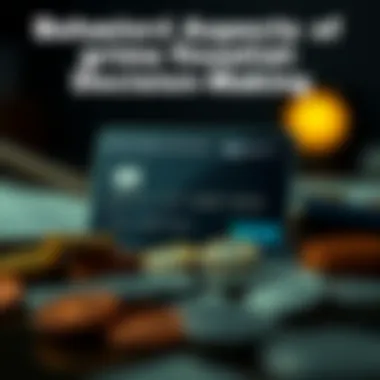Effective Strategies for Quick Credit Card Debt Reduction


Intro
Credit card debt can feel like a heavy weight on one’s shoulders. It creeps up when you least expect it and often spirals out of control before you realize what’s happening. While there are myriad approaches to dealing with this burden, understanding some key concepts can lay a solid foundation for any strategy.
In this article, we will explore effective ways to tackle credit card debt. Our focus will be on understanding interest rates, prioritizing payments, and utilizing specific repayment strategies. By equipping ourselves with this knowledge, we can move toward a healthier financial future.
Key Terms and Definitions
When delving into the world of credit card debt, it's crucial to familiarize oneself with some key terms related to this topic. Knowing what these terms mean can empower individuals to take informed actions.
- Credit Card Interest Rate: The percentage charged on the amount owed, usually stated as an Annual Percentage Rate (APR). This rate can vary based on the card and the user’s creditworthiness.
- Minimum Payment: The smallest amount you can pay each month without facing penalties. Paying only this amount can keep you in debt longer and increase interest costs.
- Credit Utilization Ratio: A measure of how much credit you’re using compared to your total credit limit. Maintaining a lower utilization ratio can positively impact your credit score.
- Snowball Method: A debt repayment strategy that focuses on paying off the smallest debts first to build momentum.
- Avalanche Method: In contrast to the snowball method, the avalanche approach prioritizes debts with the highest interest rates first, saving money in the long run.
Commonly Used Financial Products
Understanding available financial products can also provide context for the reader. Various options can aid in managing or reducing credit card debt effectively.
Some of the products include:
- Balance Transfer Credit Cards: These cards often offer low or no interest for a limited time on balances transferred from other cards, potentially saving significant interest costs.
- Personal Loans: Sometimes, consolidating debt through a personal loan can yield lower interest rates compared to credit cards.
- Debt Management Plans (DMP): Programs typically offered by credit counseling agencies that help individuals pay off their debts over an extended period, often at reduced interest rates.
Understanding these terms and products will help readers grasp strategies aimed at reducing credit card debt. With this knowledge, they can make well-informed decisions and take meaningful steps toward financial stability.
Understanding Credit Card Debt
Understanding credit card debt is more than just a handy academic exercise; it’s a vital cornerstone of financial literacy. As we dive into this article, we will explore how grasping the nuances of credit card debt influences your financial health and decision-making. Knowing the ropes can empower you to take decisive action toward managing and, ultimately, reducing your debt swiftly.
For many, credit cards are a double-edged sword. They offer convenience and the potential for rewards, yet they can also spiral out of control if mismanaged. Recognizing the intricacies behind credit card debt can not only help mitigate the risks but also enhance your overall financial acumen.
Defining Credit Card Debt
Credit card debt is essentially the balance you owe on your credit cards, which accumulates every time you make a purchase on borrowed funds without immediate repayment. This type of debt has become increasingly common as consumers lean on credit cards for everyday expenses. Take the case of someone needing to buy groceries but having little cash on hand; they may opt to swipe their card without a second thought. However, the reality is that every penny spent on a credit card adds to a mounting balance, particularly when one considers interest rates, late fees, and other charges that may be applied.
Debts incurred in this way can be categorized into two groups: revolving debt and installment debt. Revolving debt, like that from credit cards, allows you to continually borrow up to a certain limit, whereas installment debt is fixed and paid off in set amounts. This difference is crucial when assessing your overall financial landscape. Moreover, many lose sight of how quickly and uncontrollably revolving credit can grow if not carefully monitored.
The Role of Interest Rates
When it comes to credit card debt, interest rates wield a considerable influence. Typically expressed as an annual percentage rate (APR), interest rates can vary significantly from one card to another, often influenced by your credit score, payment history, and market conditions. High-interest rates can be a trap, causing your debt to snowball faster than a winter storm.
For example, if you have a card with an APR of 20%, and you carry a balance of $1,000 without making any payments, in just one year you end up paying around $200 in interest alone. This phenomenon highlights the urgency of addressing high-interest debts proactively. Knowing how to navigate interest rates can be a game changer; if possible, consider transferring balances to credit cards with lower rates or taking advantage of introductory 0% interest offers.
"Understanding your rates and fees can save you a small fortune in the long run; ignorance is not bliss when it comes to your finances."
Impact on Financial Health
The ramifications of credit card debt extend beyond mere numbers; they seep into every facet of your financial well-being. The mounting stress from unpaid bills can lead to anxiety and strained relationships. Furthermore, credit utilization—as defined by the amount of credit you’ve used relative to your total available credit—can negatively impact your credit score. A high utilization ratio suggests that you may be overly reliant on credit, which financial institutions view as a red flag.
Keeping that ratio under 30% is generally advisable if you aim to improve your financial standing. When credit card debt lingers unchecked, it can hamper your ability to secure loans for major purchases, like a home or a car, or even affect your employment opportunities in some fields. In essence, credit card debt doesn’t just weigh on your wallet; it impacts your lifestyle and future financial endeavors.
Overall, understanding credit card debt is crucial if you wish to manage it effectively and strategically reduce it. The next steps will be evaluating your situation and crafting a plan tailored to your specific circumstances.
Assessing Your Debt Situation
Assessing your debt situation is like standing at the helm of a ship before venturing out to the vast ocean. You need clarity on where you currently are to determine how to steer towards calmer waters. This process is critical because it not only provides insights into the total amount owed but also helps you identify patterns in spending and repayment. Knowing your debt situation gives you the power to make informed decisions, avoiding any pitfalls that come from overlooking the finer details.
When you grasp the full scope of your financial obligations, you are less likely to engage in behaviors that could worsen your situation. By looking into the specifics of your debt, including how it accumulates and the impact of interest rates, you gain invaluable perspective. It's akin to having a map that helps navigate financial challenges, thus transforming a daunting process into a strategic plan of action.
Calculating Total Debt
To get started, calculating total debt involves more than just tallying the numbers from your credit cards. It's about understanding the various types of debts you may hold, including personal loans, medical bills, and any other forms of borrowed money. Here's how you can go about it:
- Gather Information: Collect all your statements from each credit card and loan provider. This includes balances, minimum payments, and interest rates.
- Create a Debt Summary: A simple spreadsheet can work wonders. List all debts with their respective interest rates and total amounts owed.
- Add It All Up: Once you have everything in front of you, sum the totals.
This process not only sheds light on how much you owe in total but can also reveal the potential monthly payments required to manage each debt efficiently. You might be surprised by the Totals, as many individuals overlook a minor debt that adds up over time.
Analyzing Monthly Payments
Analyzing your monthly payments is a crucial next step. How much are you paying, and is it sufficient to chip away at the principal amount? It's common to only make minimum payments without realizing the repercussions. They often merely scratch the surface, leaving you paying much more in interest over time.
- Break Down Your Payments: Visualize your monthly outflow. Often a significant chunk is eaten up by interest, especially if the total debt is substantial.
- Assess Payment Efficiency: By using the snowball or avalanche methods as outlined elsewhere, calculate how long it will take to pay off each debt completely.
- Adjust Accordingly: If your analysis shows that it will take longer than expected, it might be time to rethink your strategies or establish a more aggressive repayment plan.


"Paying only the minimum just prolongs your debt—like running in quicksand. The sooner you break free, the better."
Evaluating Credit Utilization Ratio
Your credit utilization ratio might hold the key to revitalizing your financial health. This ratio refers to the percentage of your total credit that you are currently using. A high utilization ratio (generally above 30%) can suggest to lenders that you might be overly reliant on credit, which can hamper your credit score. Here's how you go about evaluating it:
- Determine Total Available Credit: This includes all limits from credit cards.
- Sum Current Balances: Check your outstanding balances across all credit accounts.
- Calculate the Ratio: Use the formula: (Total Balances ÷ Total Credit Limit) × 100 to get your percentage.
- A ratio under 30% is typically recommended, but if you're above it, initiate plans to reduce outstanding debt.
- It may also be prudent to consider ways to increase your credit limits, as long as that doesn’t lead to more debt!
Understanding your debt situation through these three lenses allows you to take appropriate steps towards crafting a solid debt reduction strategy. With clarity in this area, the journey towards financial recovery becomes increasingly manageable.
Payment Strategies
Effectively tackling credit card debt requires a calculated approach, and this is where payment strategies come into play. Utilizing specific payment methods can streamline your debt repayment process, alleviating financial stress while enhancing your credibility with creditors over time. These strategies enable you to choose what best suits your financial landscape, motivating you to stay the course. Each method comes with its own set of pros and cons, so it’s vital to examine them closely before diving in.
Snowball Method
The Snowball Method centers on paying off your smallest debts first while making minimum payments on larger balances. This approach is more than just a financial strategy; it is also a psychological one. By clearing out smaller debts quickly, you get a satisfying sense of accomplishment. That initial win can motivate you to keep going.
- How it Works: List your debts from smallest to largest. Focus your extra payments on the smallest balance. Once that’s paid off, move to the next smallest debt, which now feels more manageable without the previous one weighing you down.
- Benefits: The tangible progress you witness can significantly boost your morale, providing momentum as you progress. It helps build the habit of consistently making payments.
- Considerations: This method can be less efficient in minimizing interest payments, especially if your larger debts come with higher interest rates. But, if emotional reinforcement is important to you, it might be worth it.
"Money won’t make you happy — but everyone wants to find out for themselves."
Avalanche Method
The Avalanche Method flips the script. Here, your focus is on the debts with the highest interest rates. This logical approach can save you a significant amount in interest payments over time, making it an attractive strategy for financially savvy individuals.
- How it Works: Organize your debts from highest to lowest interest rates. Pay as much as possible on the debt with the highest rate while making minimum payments on the others. Once the highest debt is settled, move on to the next.
- Benefits: You can pay down debt quicker in terms of dollars and reduce the amount you spend on interest over the long haul.
- Considerations: One caveat is that you might not see immediate results if the higher interest rates correspond to larger balances, which can be demotivating at first. However, the long-term financial benefits typically outweigh the initial discomfort.
Hybrid Approaches
If you find yourself torn between the two previously mentioned methods, you might want to explore a hybrid approach. This technique lets you combine elements of both the Snowball and Avalanche methods, enabling you to tailor a strategy that meets your personal preferences and financial situation.
- How it Works: Start by focusing on a medium-sized debt with a moderately high interest rate or find a balance between smaller debts for quick wins and larger debts to minimize interest payments.
- Benefits: This hybrid method allows for flexibility. You can experience the motivational wins from the Snowball Method while also enjoying the financial prudence of the Avalanche Method.
- Considerations: While creating your own method can be beneficial, it also requires a certain level of discipline and strategic planning to ensure that you remain persistent and don’t fall back into old spending habits.
In the end, the most effective payment strategy is one that resonates with your lifestyle and keeps you motivated. Select the approach that fits best, and stick to it! Understanding your own psyche around money can be just as important as any method chosen.
Budgeting Techniques
Managing credit card debt effectively starts with understanding and mastering budgeting techniques. Having a concrete plan not only helps in keeping spending in check but also ensures that every dollar is working toward reducing your debt. When you have a well-structured budget, you're more likely to recognize areas for improvement and maintain control over your financial health. In this segment, we’ll explore how to create a realistic budget, the importance of tracking your expenses, and ways to cut unnecessary spending.
Creating a Realistic Budget
A realistic budget sets the stage for effective debt management. It involves a detailed look at your income and expenses. Start by listing all sources of income—this includes salaries, side hustles, and even assistance, if applicable. Next, categorize your expenses into fixed costs, like rent and utilities, and variable costs, such as groceries and entertainment.
One important step is to ensure that your budget is not overly restrictive. It's essential to allow for some flexibility, so you're not tempted to abandon it altogether. This means allocating a specific amount for discretionary spending, which can include dining out or hobbies you enjoy.
- Make it specific: Define how much you can spend on each category.
- Set priorities: Identify non-negotiables versus things that can be adjusted.
- Use tools: Consider utilizing mobile apps or spreadsheets to keep it organized.
By setting a realistic budget, you lay a foundation that can help you steadily chip away at your credit card debt while still enjoying life.
Tracking Expenses
Once you've established a budget, the next critical step is to track expenses. This method gives you a clear picture of how you are spending your funds day by day.
Employing various tracking methods can assist you in maintaining discipline:
- Use apps like Mint or YNAB (You Need A Budget) that provide visualized reports of your expenditures.
- Manual tracking: Keep a ledger or use a simple notebook if you prefer a non-digital approach. Each night, list your expenses to spot any patterns.
- Check bank statements regularly: This offers you a broader view and is effective for catching unnoticed charges.
The act of tracking can highlight spending habits that may be sabotaging your debt reduction efforts. It also encourages accountability, making it less likely for you to overspend.
Reducing Unnecessary Spending
Reducing unnecessary spending can seem daunting, but once you identify where your money leaks are, it’s much easier. Begin by examining your tracked expenses and asking yourself:
- Do I really need this?
- Is it worth the expense?
Here are some practical methods to cut back:


- Cancel unused subscriptions: Services can pile up, and a quick audit can reveal a few that you never use.
- Opt for home-cooked meals: Eating out may be convenient but often adds up faster than you'd like. Cooking at home is not only healthier but can significantly reduce costs.
- Limit impulse purchases: Implement a 24-hour rule—if something catches your eye, wait a day before deciding. It’s amazing how many desires fade after a short reflection.
By focusing on budget management, tracking your expenses, and reducing unnecessary spending, you enhance your capability to cut down on credit card debt efficiently. With consistent effort, you build a financial landscape that's not just sustainable but also prosperous.
Leveraging Financial Tools
When it comes to tackling pesky credit card debt, employing the right financial tools can make all the difference. It’s like having a versatile toolbox in the hands of a skilled craftsman—every tool serves a purpose and can be a game-changer in getting your financial house in order. Understanding how to use these tools effectively is crucial for strategizing your repayment plan. Not only do they help streamline debt management, but they also often provide greater flexibility and savings. Here’s a deeper look into some specific options available to you.
Debt Consolidation Options
Debt consolidation can feel like a breath of fresh air when you find yourself buried under multiple credit card bills. It involves merging several debts into one single loan, typically with a lower interest rate. By consolidating debt, you can simplify your payments and potentially lower the amount you owe over time.
- Personal Loans: A common method for consolidation is taking out a personal loan. By doing this, you pay off your credit cards and replace them with one monthly payment. While this means one less bill to manage, it's paramount to ensure that the new loan has a lower interest rate than your existing debt.
- Home Equity Loans: If you're a homeowner, tapping into your home equity can offer a lower rate. However, this route puts your home at risk, so it’s important to tread carefully and weigh the pros and cons.
- 401(k) Loans: Some people opt to borrow against their retirement savings. While it may seem appealing, remember that you're borrowing from your future self, which can have repercussions down the road.
"Debt consolidation can provide a path to clarity and progress, but it should be approached with the same caution as steering a ship through rocky waters."
In choosing a consolidation option, consider factors like fees, interest rates, and long-term financial impact.
Balance Transfers
Balance transfers can be a useful strategy for those looking to curb interest costs. Many credit cards offer promotional interest rates for balance transfers, providing an opportunity to save money. Here’s how to make the most out of this tool:
- Check for Introductory Offers: Many credit cards provide low or even 0% introductory APR on balance transfers for a set period. This can give you a window to pay off your debt without accumulating interest.
- Transfer Fees: Be cautious of balance transfer fees, which typically range from 3% to 5%. You need to calculate if the savings from interest outweigh these costs.
- Pay on Time: Missed payments can lead to the loss of the promotional rate, making sound management key. Always try to balance the temptation of transferring to a new card with your overall financial behavior.
- Limit New Charges: After transferring balances, it's critical not to add new balances to the card. This can create a cycle of debt that is hard to escape.
By evaluating your current debt and understanding your options, balance transfers can serve as a strategic move in your fight against debt.
Credit Counseling Services
Sometimes, what you really need is a guiding hand. Credit counseling services can help you navigate the stormy seas of debt. Here’s why they might be worth considering:
- Professional Guidance: A credit counseling service connects you with certified professionals who can assess your financial situation. They can offer personalized advice and suggest manageable repayment plans suited to your specific needs.
- Debt Management Plans (DMPs): These professionals often create a DMP for you, negotiating with your creditors to potentially lower your interest rates or arrange more favorable repayment terms. You’ll make a single monthly payment to the credit counseling agency, which will distribute it to your creditors.
- Educational Resources: Beyond just hands-on help, many credit counseling services provide workshops and materials on financial literacy, helping to arm you with the knowledge necessary to avoid future debt pitfalls.
- Avoiding Scams: It’s crucial to select a reputable agency. The Federal Trade Commission has resources to help you identify legitimate credit counseling services. It’s your financial well-being, after all, so do your homework.
Increasing Income for Debt Reduction
When grappling with credit card debt, it's crucial to look beyond just cutting expenses. Increasing your income can be a game-changer, providing the extra leverage needed to chip away at those balances more effectively. With rising costs and unexpected expenses, focusing solely on frugality may not suffice. Boosting your income can help slash debt faster while also allowing for some financial breathing room.
Exploring Side Gigs
Embarking on a side gig can provide that much-needed extra cash flow. Whether you have a knack for writing, graphic design, or perhaps even dog-walking, the possibilities are vast. The beauty of side gigs lies in their flexibility — you can choose what suits your schedule best. For instance, platforms like Upwork and Fiverr allow you to offer skills that can flourish outside the confines of a 9-to-5 job.
- Freelancing: Utilize your skills to take on projects in your field of expertise.
- Gig economy jobs: Consider driving for Uber or delivering food for DoorDash.
- Tutoring: Offer your knowledge in a subject to students who might be struggling.
With creativity and time management, side gigs can snowball into a substantial income over time. Just remember to keep track of any earnings for tax season!
Negotiating Salary Raises
Another effective way to increase your cash flow is negotiating a salary raise. This is often overlooked. Employees sometimes hesitate to ask for more, believing it may seem greedy or unwarranted. Yet, many businesses expect their staff to advocate for themselves. Research can be your best friend here. Know the market rate for your position and express your value within the company during a performance review.
- Prepare a list of your accomplishments and how they’ve benefited the company.
- Be clear but respectful in your request, articulating why you believe a raise is justified.
- Consider timing: asking after a big project whooped your department may increase your chances.
Successful negotiation can pave the way for not only a raise but potentially other benefits like bonuses or paid training, all of which can help in tackling credit card debt.
Selling Unused Assets
One person’s clutter can be another person’s treasure. Look around your home; you likely have items that are simply collecting dust. Selling unused assets can be a fast-track strategy to drum up cash for debt payment. Think about any gadgets, furniture, or even collectibles that may have value.
- Online marketplaces: Websites like eBay, Craigslist, and Facebook Marketplace can help unload unwanted items efficiently.
- Garage sales: Nothing beats a good old-fashioned garage sale for attracting local buyers looking for bargains.
- Trade-in programs: Consider tech trade-in programs offered by companies like Apple or Best Buy.
Take the time to reassess your belongings and realize their potential market value. You might be surprised at how much cash can come from decluttering.
Remember: It’s all about taking that extra step. Every little bit of income can help reduce the weight of credit card debt, leading to a more stable financial future.
Behavioral Aspects of Debt Management
Managing credit card debt, though often viewed through a numerical and strategic lens, has a significant behavioral component. The way individuals perceive, react to, and handle their financial situations can profoundly impact their ability to reduce debt effectively. Understanding these behavioral aspects is vital because it allows one to pinpoint specific roadblocks—be they emotional or situational—that may impede progress in debt reduction. Recognizing these elements can lead to more intuitive decision-making, minimizing the risk of falling back into the cycle of accumulating debt.
A sound grasp of behavioral finance helps in developing skills to not only manage present debts but also shapes a more disciplined long-term financial approach. By addressing the behavioral facets of debt management, one can equip oneself with the tools needed to build and maintain healthier financial habits. This section will delve into understanding the triggers that lead to debt accumulation and recognizing the tendencies towards emotional spending.
Understanding Triggers for Accumulation


Triggers for accumulating credit card debt can arise from various sources, both internal and external. Often these triggers stem from lifestyle choices, societal pressures, or even habitual behaviors. For instance, a person might find themselves consistently adding to their credit card balance due to the desire to fit in with peers who frequently indulge in dining out or other luxuries.
Identifying these triggers is crucial for breaking the chain of behavior that leads to higher debt. Here are some common triggers that lead to debt accumulation:
- Lifestyle Inflation: As income increases, so do expenditures, often leading to unnecessary upgrades in lifestyle.
- Peer Pressure: Being surrounded by friends or colleagues who frequently spend can incite similar behavior, leading to unwarranted debt.
- Marketing Influence: Promotional offers and advertising can instigate impulsive buying decisions, nudging one into using credit instead of savings.
It might be helpful to keep a diary or track feelings and situations leading up to unplanned purchases. Recognizing patterns in these behaviors can lay a foundation for change. By effectively managing these triggers, individuals can take the reins of their financial habits, transforming impulsive tendencies into calculated decisions.
Recognizing Emotional Spending
Emotional spending is another detrimental habit that contributes significantly to the accumulation of credit card debt. Many individuals turn to shopping as an outlet for stress, boredom, or anxiety. When confronted with negative emotions, it can be easy to justify a purchase as a form of instant gratification, but this often leads to regret and deepening financial woes.
Here are key considerations for recognizing and managing emotional spending:
- Awareness of Emotions: Invest time in understanding what emotions lead to the urge to shop. Are you often reaching for that credit card when feeling sad, anxious, or even celebratory?
- Timing: Implement a waiting period before making unscheduled purchases. If the urge still exists a day or two later, perhaps it's worth reconsidering.
- Alternative Coping Strategies: Developing hobbies or practices to manage emotions without spending, like exercise or art, can serve as productive outlets.
Acknowledging emotional spending as part of one’s debt accumulation cycle can be an eye-opener. Once realized, it’s possible to address those emotions more healthily and keep debt at bay.
In essence, understanding the behavioral aspects related to debt management paves a smoother path for financial recovery. It’s not merely about the arithmetic of payments and balances; it’s about understanding oneself and making conscious, informed choices.
Establishing Long-term Financial Habits
Establishing long-term financial habits is akin to planting a tree: with patience, nurture, and time, it bears fruit in the form of financial security. While rapidly reducing credit card debt is essential, cultivating habits that promote sustained financial health should not be overlooked. Many people take a patchwork approach to managing their finances, treating symptoms without addressing the root causes. That’s where long-term habits come into play; they create a foundation that helps you not only tackle current debt but also navigate future financial waters with confidence.
The key elements of establishing these habits include setting realistic financial goals, maintaining an emergency fund, and regularly reviewing your financial situation. When you engage in practices that keep your financial well-being in check, you significantly improve your chances of avoiding the pitfalls of debt accumulation in the future.
Setting Financial Goals
Setting financial goals gives you a target to aim for, much like a compass guiding you through uncharted territory. Without specific goals, you may find yourself drifting aimlessly through your financial life. Think of goals in both the short-term and long-term context. For immediate concerns, it might be about paying off a specific credit card; whereas longer-term goals could involve planning for retirement or saving for a major purchase.
Here are some tips for setting effective financial goals:
- Be Specific: Instead of saying "I want to save money," articulate a figure, like "I aim to save $5,000 within the next year."
- Make it Measurable: Develop milestones. For instance, breaking down that $5,000 into monthly savings targets can make it more manageable.
- Keep it Realistic: Goals should be achievable based on your income and expenses. Setting impossible goals only sets you up for disappointment.
Integrating these elements into a structured plan makes reaching your targets much more feasible. As you achieve smaller goals, you build self-confidence and accelerate towards more expansive financial objectives.
Maintaining an Emergency Fund
Life is unpredictable; having an emergency fund is like keeping an umbrella handy for an unexpected shower. This fund acts as a safety net, giving you the peace of mind to make decisions free of fear related to potential unforeseen expenses. Financial experts generally recommend saving at least three to six months' worth of living expenses.
Establishing an emergency fund serves multiple purposes:
- It reduces reliance on credit cards or loans in times of crisis, allowing you to focus on debt reduction.
- It protects against the stress of unexpected expenses, mitigating emotional spending impulses.
To build this fund, consider setting up automatic transfers to a separate savings account each payday. This way, saving becomes a priority rather than an afterthought. Even a small amount can accumulate over time and provide a significant buffer against financial shocks.
Regular Financial Review
A regular financial review is like a regular check-up for your wallet. It involves assessing your income, expenses, and overall financial health. Without periodic evaluations, it's easy to lose sight of your financial status and unintentionally drift back into bad habits.
Set aside time, perhaps monthly or quarterly, to analyze your finances. Review essentials like:
- Income and Expenses: Are you overspending in certain areas?
- Debt Levels: Ensure you're progressing on paying down credit cards and other debts.
- Investment Growth: Are your investments meeting your expectations or need adjustments?
By putting this practice in place, you not only stay informed but can also adapt as your financial landscape changes over time.
"Consistency in managing your financial habits is the investment that pays off exponentially over time."
In the end, establishing long-term financial habits is about cultivating a disciplined attitude toward your finances. Goal-setting, maintaining an emergency fund, and regular reviews form a solid backbone to support your journey in reducing credit card debt and achieving lasting financial stability. For more insights, visit NerdWallet or The Balance.
End
As we wrap up the discussion, it's clear that the journey of managing credit card debt can be daunting, but it's not insurmountable. Understanding the strategies available allows individuals to tackle their debts head-on and pursue the ultimate goal of financial freedom. Each approach presents distinct advantages, depending on a person’s unique circumstances.
The Path to Financial Freedom
Achieving financial independence is not merely about paying off debts; it's about cultivating sustainable habits that prevent the accumulation of debt in the future.
Key elements to consider include:
- Commitment to a Structured Payment Plan: Following strategies like the Snowball or Avalanche methods makes a big difference in motivation and effectiveness.
- Importance of Budgeting: Keeping a close eye on income and expenditures can unveil spending patterns that may need adjustment.
- Acknowledging the Emotional Side: Many accumulate debt due to emotional spending or impulse buys, recognizing these triggers is vital.
- Setting Clear Goals and Monitoring Progress: Setting achievable financial milestones can provide momentum and motivation.
In summary, navigating the maze of credit card debt requires a mix of discipline, awareness, and strategy. With the right tools and mindset, what once seemed a Herculean task can transform into a structured path toward financial stability.
By implementing these strategies and maintaining a proactive mindset, anyone can begin to reduce their debt effectively and pave the way to a more secure financial future. Remember, this is a marathon, not a sprint. Each small step counts towards reaching the finish line.



